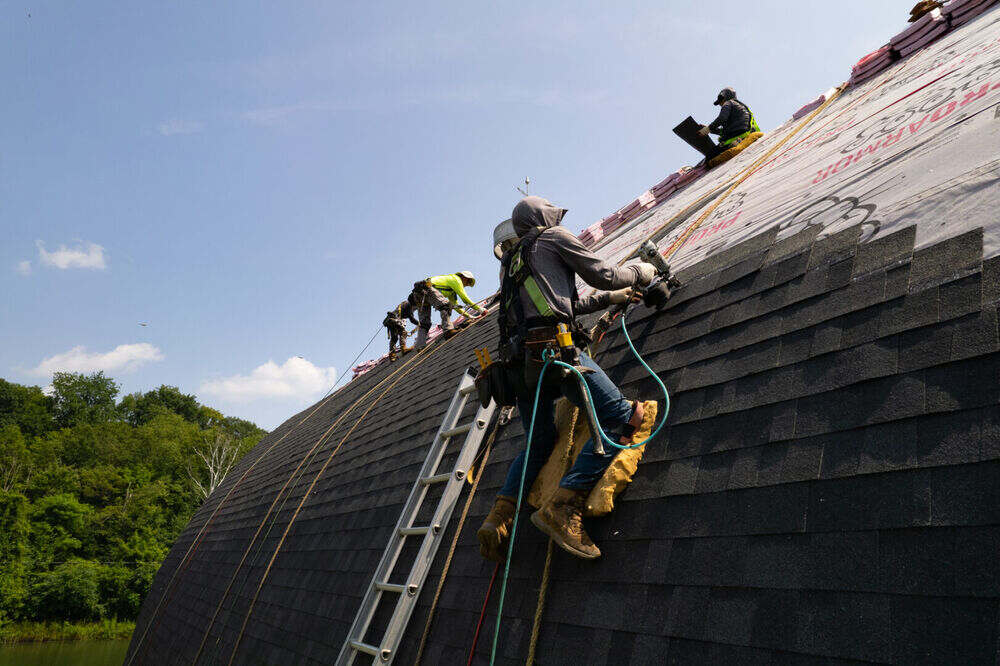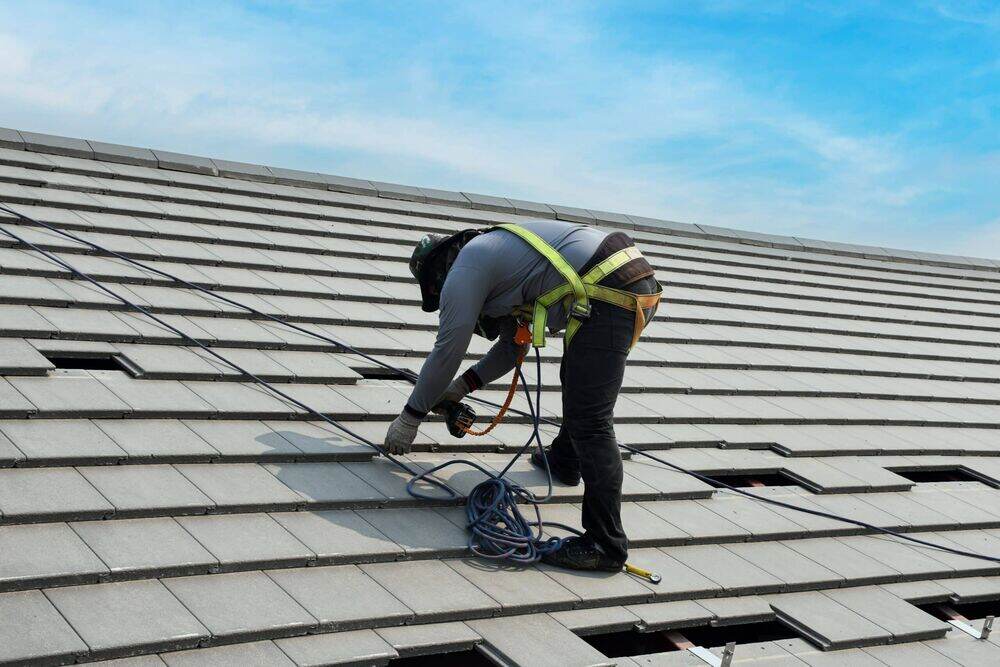In Pleasant Valley, where seasonal storms, heavy winds, and tree-lined streets are part of everyday life, even well-built roofs can suffer minor wear and tear. While a missing shingle or small leak might seem harmless at first, overlooking early signs often leads to bigger, costlier issues down the road. Acting quickly with the right approach can save property owners from unexpected stress, structural damage, and emergency roof repair costs.
Here are five practical steps for handling minor roof damage repair with confidence and care.
Table of Contents
Key Takeaways✔ Minor roof damage can quickly escalate without timely roofing repair. ✔ Safety should always come first when performing any roof damage repair. ✔ Replacing shingles and sealing leaks are key parts of effective roof repair services. ✔ Temporary fixes like tarps and roofing cement help during emergency roof repair situations. ✔ Regular inspections and gutter cleaning prevent future professional roof repair needs. ✔ Choosing the right emergency roof repair contractor ensures fast, reliable results. ✔ Roofer of Pleasant Valley offers trusted, local roof repair services in Pleasant Valley, NY. |

1. Prioritize Safety Before Climbing the Roof
Before beginning any roof damage repair, it’s critical to focus on personal safety. Even small roofing repair tasks can lead to serious injuries without proper precautions. Planning ahead and setting up the right safety measures can make all the difference.
How to Safely Prepare for Minor Roof Repair
- Inspect the Weather Forecast: Check the forecast for at least a 48-hour window of clear, dry weather. Roofing materials can become slick even with morning dew, and a sudden downpour during a roof repair services task could increase the risk of slipping, losing tools, or making the problem worse.
- Use Proper Safety Equipment: A harness anchored to a secure point is essential for sloped or two-story roofs, especially when performing emergency roof repair after a storm. Non-slip shoes, safety glasses, gloves, and a hard hat help protect against falling debris, sharp nails, and hot shingles on sunny days, making the entire process safer and more controlled.
- Clear the Area Below: Move patio furniture, grills, or vehicles away from the house to prevent damage from falling tools or materials. Use bright cones or tape to mark the area off, especially if other people are nearby, which is a must for any professional roof repair team or cautious property owner.
2. Remove Damaged Shingles or Flashing
Before any repairs begin, damaged materials need to be removed with care. Broken or lifted shingles and flashing create entry points for water, pests, and wind. Taking time to remove them properly avoids worsening the problem and sets a clean foundation for roof damage repair.
How to Safely and Effectively Remove Damaged Materials
- Identify the Affected Area Thoroughly: Examine the roof from multiple angles to spot torn, curled, or missing shingles. For flat areas, look for discoloration or soft spots, which may signal moisture damage needing immediate roofing repair.
- Loosen Shingles Without Hurting Nearby Sections: Use a flat pry bar or roofing shovel to gently lift the nails and remove only the affected piece. Avoid tearing the surrounding shingles or underlayment—precision here ensures the rest of the roof stays intact and reduces the need for broader roof repair services.
- Remove Old Flashing Around Chimneys and Vents: Carefully slide out rusted or bent flashing using a flat-head screwdriver or chisel. If water has been leaking through those areas, replacing flashing is a key step in professional roof repair to prevent long-term structural damage.
3. Install New Shingles or Flashing
Once the damaged areas are cleared, the replacement phase begins. Installing shingles or flashing might seem straightforward, but proper alignment and securing methods are vital to prevent future issues.
How to Install Replacement Roofing Materials Properly
- Match Shingles by Style and Material: Choose replacement shingles that closely match the existing roof in color, size, and material. Inconsistent shingles can stand out visually and may not perform as well under pressure, leading to repeat roof damage repair.
- Secure Shingles with Correct Nail Placement: Use roofing nails to fasten the new shingle just above the tar strip, typically four nails per piece. This creates a water-tight seal and resists strong wind uplift, a crucial factor in Pleasant Valley’s storm-prone seasons.
- Install Flashing with Overlap and Sealant: New flashing should overlap shingles and sit flat against the surface to direct water away from seams. Apply roofing sealant underneath and along edges—this is a standard for any professional roof repair job and ensures durability against heavy rain or melting snow.
4. Seal the Area and Test for Leaks
After installing the new materials, sealing the area is critical to protect against water intrusion. Even a small gap can allow leaks that lead to mold, stains, and insulation damage. This step is especially important in emergency roof repair situations where fast weatherproofing matters.
How to Seal Repaired Sections to Prevent Leaks
- Apply Roofing Cement Under Edges and Nail Heads: Use a caulking gun or trowel to place roofing cement under the shingle edges and over each exposed nail head. This step locks everything in place and prevents water from slipping underneath, a basic but crucial move in roof damage repair.
- Use Waterproof Tape or Membrane on Larger Areas: For broader patches or around vent openings, self-adhesive waterproof membranes add an extra layer of protection. Many roof repair services recommend this for added security, especially if the home has a low slope or older underlayment.
- Conduct a Gentle Water Test: After allowing sealants to cure, run a controlled stream of water over the repaired section. Have someone inside check for leaks or moisture spots—this mimics rainfall and ensures the emergency roof repair holds up before the next storm hits.
5. Clean Up and Plan for Regular Maintenance
Once the repair is complete, cleaning the site and setting a maintenance plan helps extend the life of the roof. A tidy job site prevents leftover debris from causing damage, while a simple inspection schedule can help avoid future emergency roof repair needs.
How to Wrap Up Repairs and Stay Ahead of Future Damage
- Remove All Debris and Leftover Materials: Gather and dispose of nails, broken shingles, and sealant containers to avoid injuries or clogged gutters. A clean area reflects the care taken during the roofing repair and leaves no hazards behind.
- Take Photos and Notes for Reference: Document the repair with before-and-after photos and a short log of what was done. This can help during insurance claims or when speaking with a professional roof repair team for future inspections.
- Create a Seasonal Maintenance Checklist: Plan to inspect the roof every spring and fall, after major storms, and before winter sets in. Routine roof repair services—even just minor touch-ups—can catch issues early, keeping Pleasant Valley homes protected and costs low.

How to Spot the Difference Between Minor and Major Roof Damage
Not all roof issues are created equal. Some problems are quick fixes with a simple patch or shingle replacement, while others need full-scale professional roof repair. Knowing the difference helps prevent unnecessary costs—or worse, missed signs of serious structural damage.
1. One or Two Missing Shingles vs. Large Bald Spots
If only one or two shingles are missing after a storm, it’s typically a case of minor roof damage repair. These can often be replaced without needing deeper structural assessment. However, if there’s a large bald spot exposing the underlayment, it signals a more serious issue that requires immediate roofing repair by a professional.
2. Small Leak During Rain vs. Recurring Water Stains
A small, one-time leak during a storm might be fixed with emergency roof repair using sealant or a temporary patch. But recurring water stains on ceilings or walls suggest long-term water infiltration. That’s often a sign of deeper problems requiring full roof repair services to prevent mold or framing damage.
3. Curled Shingles vs. Cracked or Split Ones
Curled shingles are common with age or heat exposure and can usually be resolved with minor roofing repair. Cracked or split shingles, especially in large numbers, often point to brittle materials or impact damage. In those cases, professional roof repair is essential to prevent leaks and weather exposure.
4. Minor Flashing Shift vs. Detached or Rusted Flashing
If flashing has shifted slightly but remains intact, a quick reposition and reseal may be enough. However, flashing that’s detached, rusted, or missing altogether opens the roof to water damage at critical seams. That kind of roof damage repair typically involves removing nearby shingles and installing new flashing through proper roof repair services.
5. Granule Loss in Gutters vs. Exposed Fiberglass on Shingles
Some granule loss is normal over time and appears as sandy residue in gutters. But if fiberglass backing is visible on shingles, the protective layer is gone—indicating advanced wear. That’s a major red flag for professional roof repair and likely signals the need for a larger section replacement.
6. Isolated Sagging Gutter vs. Roofline Sag or Dip
A sagging gutter could be due to loose hardware or debris buildup and is often resolved during minor roofing repair. A dip or sag in the roofline itself, however, suggests rot or broken support beams underneath. That calls for emergency roof repair and structural assessment by qualified roof repair services.
Temporarily Patching a Leak Until Help Arrives
When a leak starts and professional roof repair can’t happen right away, quick action can prevent more serious damage. Whether it’s heavy rain or a storm-damaged shingle, temporary fixes buy time until full roof repair services can step in. The key is using the right materials and methods to keep water out and reduce the risk of emergency roof repair getting worse.
1. Use a Waterproof Tarp for Immediate Coverage
Secure a heavy-duty waterproof tarp over the damaged area using 2×4 boards and nails or screws along the edges. Make sure the tarp extends at least 3 feet beyond the leak in all directions to divert water away from the compromised section. This roofing repair method is fast, effective, and widely used during emergency roof repair situations.
2. Cover the Leak From Inside With a Bucket and Plastic Sheeting
If water is dripping through the ceiling, place a bucket beneath the leak and tape heavy plastic sheeting to the ceiling as a funnel. This helps direct the flow and prevents water from soaking insulation or drywall. Though it doesn’t stop the leak at its source, it limits interior damage while waiting for professional roof repair.
3. Create a DIY Rubber Patch Using Inner Tube Material
For small punctures, a strip of rubber from an old tire inner tube or bike tube can work as a temporary patch. Nail it down over the damaged section and seal the edges with roofing cement. It’s a creative emergency roof repair trick that’s especially useful when supplies are limited.
How to Choose the Right Emergency Roofing Repair Service
In urgent situations, it’s tempting to go with the first contractor available. However, not all roof repair services are created equal, especially in a market where residential roofing services alone contributed $14.96 billion to the roofing industry’s total revenue in 2024. Knowing what to look for helps protect property, budget, and peace of mind.
1. Look for Local Experience in Roof Damage Repair
Choose a contractor in Pleasant Valley, NY, who has worked in Pleasant Valley and understands the local weather patterns, building codes, and common roof issues. Local professionals often respond faster during emergency roof repair situations and know how to handle regional challenges like heavy snow or fallen tree limbs. Their experience helps ensure a smoother, more reliable roofing repair.
2. Verify Licensing, Insurance, and Certifications
Always confirm that the emergency roof repair contractor holds proper state licensing and carries both liability insurance and workers’ compensation coverage. This protects homeowners from being held liable for injuries or accidental damage during the repair. Certified roofers also tend to follow better safety standards and deliver higher-quality professional roof repair work.
3. Ask About Availability for 24/7 Emergency Services
Not every roofer offers round-the-clock availability, so it’s important to ask upfront. A dependable emergency roofing repair service will answer calls after hours and dispatch a crew when a storm hits, even at night or on weekends. Fast response time is essential to limit water intrusion and prevent further roof damage repair.
4. Check Reviews and Referrals for Roof Repair Services
With the employment of roofers expected to grow by 6% from 2023 to 2033, choosing a reputable contractor becomes even more important in a competitive market. Online reviews, Better Business Bureau ratings, and local references reveal a contractor’s reputation—look for consistent praise in handling emergency roof repair, keeping appointments, and communicating clearly.
5. Request a Written Estimate Before Work Begins
A reliable roofing repair contractor will provide a clear written estimate that details the scope of work, materials, and cost. This helps avoid misunderstandings and ensures everyone is aligned on what the emergency roof repair involves. Steer clear of roofers who pressure for payment before work or dodge basic documentation.
6. Evaluate Their Warranty and Follow-Up Support
Even emergency roof repair should come with a warranty, especially if new shingles, flashing, or sealants are installed. Ask about their policy on follow-up inspections or repairs if issues resurface. A professional roof repair team will stand behind their work and offer roof repair services that prioritize long-term solutions, not quick cover-ups.
Frequently Asked Questions (FAQs)
Can clogged gutters cause roof damage that needs repair?
Yes, clogged gutters can cause water to back up onto the roof, soaking the shingles and eventually seeping into the decking. This moisture buildup often leads to leaks and costly roof damage repair if ignored. Many professional roof repair teams recommend cleaning gutters at least twice a year to prevent these issues.
How long does a minor roofing repair usually take?
A typical minor roofing repair—like replacing a few shingles or patching a small leak—can often be completed in under two hours. Emergency roof repair might take longer if weather is a factor or if damage is hard to reach. Roof repair services may also schedule a return visit to ensure the fix holds up.
What materials are best for small-scale roof damage repair?
For small repairs, asphalt shingles, roofing cement, sealant, and galvanized nails are often enough to complete the job. Roofing tape and waterproof tarps are also useful in emergency roof repair scenarios. Choosing the right materials ensures the professional roof repair lasts through storms and seasonal weather.
Can solar panels make roof repair harder or more expensive?
Yes, roofs with solar panels may require extra time or labor during roofing repair since panels often need to be detached to access the damaged area. This can increase the cost of both emergency roof repair and routine roof repair services. It’s important to hire professionals experienced in handling solar-equipped roofing systems.
Does insurance cover all roof damage repair costs?
Not always—insurance typically covers roof damage repair only when it’s caused by a sudden event like hail, wind, or falling debris. Routine wear and tear or poor maintenance is often excluded, even if emergency roof repair is needed later. It’s best to review policy details or consult with a professional roof repair company familiar with insurance claims.
Get Trusted Roof Repair Fast with Roofer of Pleasant Valley
When a leak, missing shingle, or storm damage threatens your roof, Roofer of Pleasant Valley is the name homeowners trust for prompt, reliable service in Pleasant Valley, NY. With a team that knows the local weather and roofing needs inside and out, we deliver efficient roofing repair and emergency roof repair without the hassle. Whether it’s a quick patch or full professional roof repair, our crew handles each job with care and precision.
Don’t wait for minor issues to become major—reach out today and get roof repair services that keep your home protected year-round!

